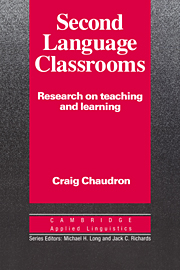Book contents
- Frontmatter
- Contents
- List of tables and figures
- Series editors' preface
- Preface
- 1 Major issues in second language classroom research
- 2 Classroom research methods
- 3 Teacher talk in second language classrooms
- 4 Learner behavior in second language classrooms
- 5 Teacher and student interaction in second language classrooms
- 6 Learning outcomes
- 7 Directions for research and teaching
- References
- Index
- Frontmatter
- Contents
- List of tables and figures
- Series editors' preface
- Preface
- 1 Major issues in second language classroom research
- 2 Classroom research methods
- 3 Teacher talk in second language classrooms
- 4 Learner behavior in second language classrooms
- 5 Teacher and student interaction in second language classrooms
- 6 Learning outcomes
- 7 Directions for research and teaching
- References
- Index
Summary
This book reviews classroom-based research and attempts to provide confirming or disconfirming evidence for claims about the influence of language instruction and classroom interaction on language learning. This is achieved by comparing studies that describe teachers' and learners' behaviors in classrooms and synthesizing them into generalizations about the processes that take place in second language classrooms. Studies that point to relationships between these behaviors and second language development are also summarized. Classroom teachers, school administrators, teacher trainers, and second language researchers should all find in the review of these relationships useful implications for language teaching, language curriculum development, and further research goals. Theories and claims about language teaching methods, effective curriculum, or the importance of learner characteristics have rarely been based on actual research in language classrooms, despite the integral role that classroom teaching and learning plays in theoretical and practical proposals.
Also, professionals involved in first language pedagogy should find many methods and principles relevant to their educational context, because studies of second language instruction have addressed issues analogous to those in native language educational research, and the goals of the research are quite similar. In second language (L2) research the greater attention to the linguistic phenomena involved can afford some important perspectives for first language (L1) researchers. A linguistic focus has been evident in much L1 classroom research (e.g., Bellack et al. 1966; Cazden, John, and Hymes 1972; Wilkinson 1982), yet L2 researchers have at times maintained greater precision about the nature of the linguistic phenomena and greater caution in interpreting the meaningfulness of classroom events for the participants.
Information
- Type
- Chapter
- Information
- Second Language ClassroomsResearch on Teaching and Learning, pp. xv - xviiiPublisher: Cambridge University PressPrint publication year: 1988
